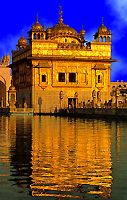|
|
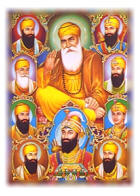 |
Historical
development
(follow links below for details on the life of each guru)
A succession of 10 Living
Gurus over 200 year period (till 1708) developed the faith; seen by Sikhs as
embodying the same spirit of the Guru present in Nanak
Here
is a page
with a "family tree" chart of the gurus, showing their
relationship to each other and also outlining highlights of their lives
|
-
2nd guru (Angad
Dev)
created written form of the Punjabi language for use in writing Sikh
scripture
-
3rd guru (Amar
Das)
instituted the community kitchen (Langar) to serve all regardless of
caste, social status or religion. If a person desires to worship with Sikhs
they were to demonstrate their true acceptance of social equality by sitting
side by side to eat a meal with people of lower class status. Even Kings
were to sit on the ground with the lowest of Indian social caste.
To this day the Langar meal remains an essential part of Sikh practice: to
both worship as well as eat a meal together as one community.
-
4th guru (Ram
Das)
built the Sikh holy city of Amritsar
-
compiled the sacred
scripture of the Sikhs - the Adi Granth comprised of hymns (set to
traditional tunes - ragas) from Kabir, Nanak, the other Sikh gurus
and even hymns and writings of Hindu and Muslim saints There was no
discrimination regarding who composed the hymns or what religion
they were from. The sole consideration was the content and meaning of the
hymns: that they were in-line with Sikh beliefs.
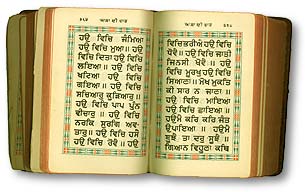
Learn
more about the Adi Granth
-
Har
Gobind began martial arts training amongst the sikhs, was imprisoned
for his faith
-
Har
Rai set up a hospital to care for the sick
-
Har
Krishan the child-guru! He was just aged 5 when he became guru and
died at age 8 of small pox, which he caught as he helped treat others who
were sick
-
Tegh
Bahadur was martyred, after much travel and preaching throughout
India, attracting many to adopt Sikh teachings as their own
-
declared the Sikh
community (Khalsa) and the sacred scripture (Guru Granth Sahib) as
guru thus ending the line of human gurus. A single leader can be easily
killed but when the leader is a book and the entire community it is much
harder to destroy
-
in 1699 he instituted
the Khalsa ("The Faithful" - community of the faithful,
brotherhood) as a military defense unit.
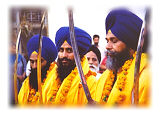
Members of the Khalsa...
-
are initiated with
the Amrit ceremony: simple initiation
ceremony (baptism) drinking sweetened water out of same cup (indicating
equality among all members)
-
are renamed Singh
("lion") or Kaur ("Princess") (same name =
one family)
-
are to abstain from
intoxicants (drugs, alcohol and tobacco)
-
wear the "Five
Kís" by which to stand out with pride from non-Sikhs rather
than to hide. So called because the name of each symbol in Punjabi
begins with a "k":
|

|
Kesh: uncut
hair (lionís mane, symbol of strength)
The
significance of hair in Sikhism
(a PowerPoint presentation)
Sikh men who are
members of the Khalsa wrap their long hair under very distinctive
turbans
How
can you tell a Sikh turban from similar head coverings? Check
out this webpage.

(click picture for larger, readable image)
|

|
Kangha: comb
(to maintain cleanliness)
|
 |
Kachha: special
underbreetches (for chastity and readiness in case of sudden
attack)
|
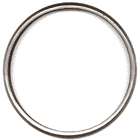 |
Kara: steel
bracelet (worn on the right wrist to remind one of God as it jangles when going about daily activities. Steel is
affordable for all, rich or poor)
|
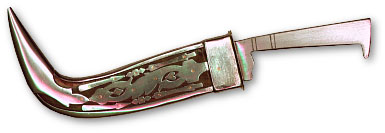 |
Kirpan: small
dagger (for defensive purposes only - today it is just symbolic and
would hardly open a letter)
|
Throughout 18th cent.
continued persecution and attacks on Sikhs who remained on defense
In 19th cent., under
British rule, Sikhs gained a better standing; strong numbers in British army
While the majority of Sikhs
remain in India, some have migrated to other areas of the world:
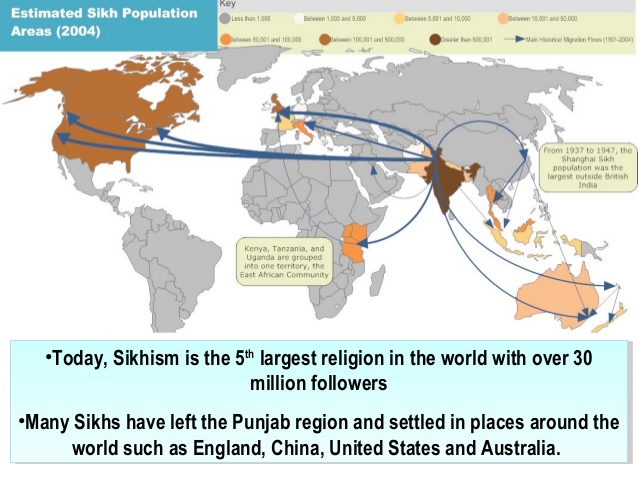
(Click picture for larger, more readable image)
Today political problems
remain for Sikhs as they lobby for an independent Sikh state in the Punjab
Learn
what happened with the Sikhs in India in 1984 (when Indira Gandhi was assassinated
by her Sikh body guard) - from the
Sikh perspective
return to top
|

